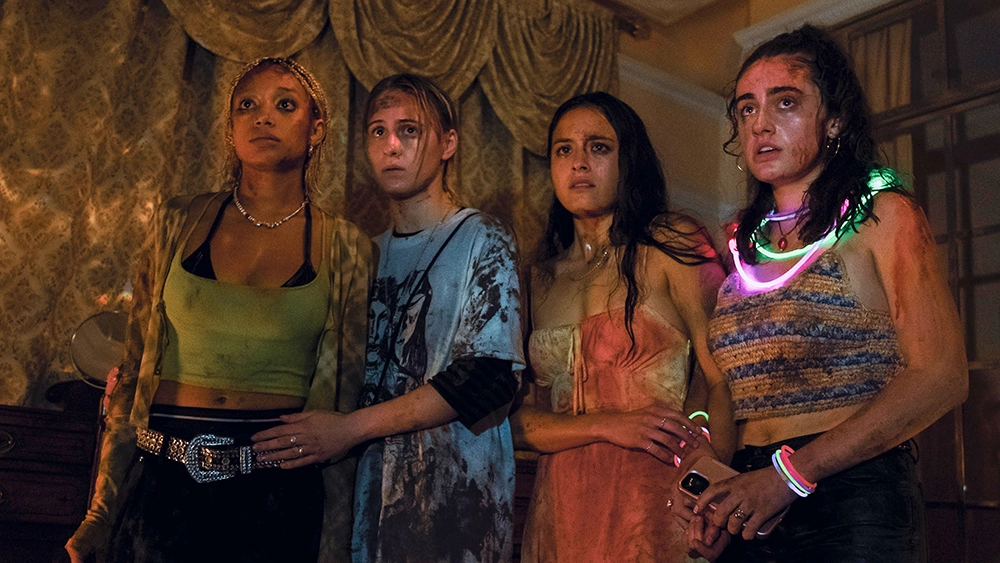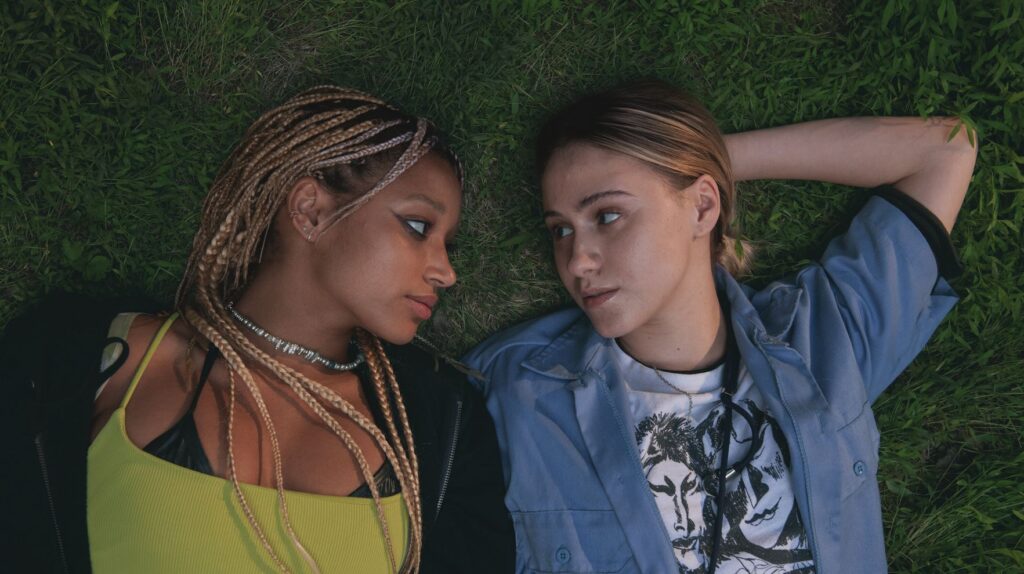
The murder mystery gets a modern makeover in Bodies Bodies Bodies, the slick, enjoyable, somewhat obnoxious thriller from Halina Reijn. As the title suggests, corpses slowly stack up over the course of the movie, though the bloodshed is less a sign of inhuman evil than a natural consequence of characters lacking access to wifi. After all, when you can’t check your Instagram account, what else is there to do but kill people? Adapting a witty, smirky screenplay by Sarah DeLappe, Reijn has crafted a confident and provocative picture in which new-age brashness nestles up against cinematic classicism. It’s Agatha Christie on TikTok.
The setting, quite delectably, is a dark and stormy night. Seven attractive young people pile into a mansion in upstate New York, not that far from where Clue took place. This privileged septet has assembled, in advance of the landfall of a hurricane, for an evening of revelry—a bawdy, corrosive cocktail spiked with sex and drugs and jealousy. Before long, one of them is dead, resulting in a hectic, bloody night full of paranoia, finger-pointing, and violence. Whaddya need, a GPS-powered roadmap?

Movies like this tend to live or die less on the particulars of their plot (who’s the killer? who cares?) than on the imagination of their set pieces and the delineation of their characters. On the latter count, Bodies Bodies Bodies fares reasonably well. The well-scrubbed knaves who populate the screen don’t entirely transcend their archetypes—the slacker, the addict, the naïf, the sexpot—but the capable cast helps imbue these wealthy delinquents with a measure of personality. Our surrogate is Bee (Borat 2’s Maria Bakalova), the newcomer whose anxiety at the prospect of keeping straight a bunch of new faces mirrors our own. Bee is in puppy love with Sophie (Amandla Stenberg, from The Hate U Give), who’s childhood friends with David (Pete Davidson), who’s dating Emma (Chase Sui Wonders) but who’s also weirdly close with Alice (Rachel Sennott, best in show), who’s sleeping with Greg (Lee Pace, reeking of sex appeal and indecency), who’s the only true adult surrounded by a crowd of Gen Z knuckleheads. Rounding out the crew is Jordan (Industry’s Myha’la Herrold), who seems to possess shared history with everyone else in the house. (One advantage of featuring multiple queer characters with possibly fluid sexual preferences is that the potential rivalries multiply; the more people who might want to fuck each other, the greater the opportunity for resentment, suspicion, and literal back-stabbing.)
Before the bodies hit the floor, DeLappe’s script exhibits a fluency in young-speak—that caustic dialect of passive-aggressive hostility, sexual bravado, and intellectually versatile touchiness. “You’re gaslighting me!” someone wails, prompting a rant from her purported tormentor about how people wield the word “gaslighting” indiscriminately. Later, someone else will complain about being triggered, while another will accuse a fellow guest of being ableist. This is acutely contemporary language, yet it’s deployed to convey a very traditional idea: that these smart, smug people collectively embody a powder keg of bitterness and volatility. Essentially, Bodies Bodies Bodies resembles The Big Chill, except that instead of the characters gathering to mourn a friend’s death, they’ve gathered to die.

About which: Beyond constructing the movie as an escalating series of nightmarish events—the verbal assaults are soon replaced by physical attacks, and the jokes and taunts are quickly accompanied by knives and guns—Reijn has imposed on herself an interesting formal challenge. Once the hurricane hits, the power goes out, and the characters are plunged into actual as well as metaphorical darkness. This means that the only apparent sources of light emanate from portable devices: flashlights, headlamps, and of course glowing smartphone screens. It’s an intriguing offshoot of the found-footage genre, but Reijn doesn’t do much with the conceit; for the most part, the film just looks dim, without sporting any memorable images. (The percussive score, by Disasterpeace, is appropriately sinister and moody.)
The other difficulty Reijn faces is more typical: the sense of arbitrariness that attends most whodunits. Encouraging audiences to speculate about the true identity of the killer—he did it! wait, she did it!—is a familiar cinematic pastime, but it often suffers from diminishing returns, prioritizing haphazard shocks at the expense of true mystery or suspense. (Knives Out, the best recent exemplar of the genre, evaded this trap by weaving its steady stream of surprises into the parallel story of a suspect trying desperately to cover her tracks.) To its credit, Bodies Bodies Bodies never relinquishes its impish spirit; instead, as the blades slash and the bullets fly, it takes pains to heighten its carefully cultivated atmosphere of youthful grievance. I admit to chuckling—and also to nodding in solidarity—when Alice, confronted at gunpoint about the banality of her hobbies, shrieks that “A podcast is a lot of work!” (Sennott’s ability to sell lines like that is what makes her performance so good, and her counterpart so disturbingly recognizable.)

At the same time, the movie’s relentless meanness—its insistence on overlaying its screamy antics with a coating of glib mockery—can feel, as one of its victims would say, so toxic. The problem is not that the characters are unlikable, or that they react to a terrifying situation by becoming (really, by continuing to be) selfish and vindictive; in context, such behavior is realistic and persuasive. The problem is that Reijn and DeLappe plainly view the participants in their murderous guessing game—which, it should be noted, delivers an unusually satisfying final reveal—as caricatures rather than people. When Alice responds to a heartfelt admission of vulnerability with the faux weighty confession, “I have body dysmorphia,” we’re meant to laugh at her self-absorption, but by that point she’s too easy a target. The film’s supposedly scabrous tone is more lazy than cutting, its pervasive judgment less scathing than condescending.
I’ve seen Bodies Bodies Bodies described as a satire, which makes me wonder: What, exactly, is it satirizing? Rich kids? Wokeness? The notion that teenagers and twentysomethings can be fickle, narcissistic, and cruel? There’s nothing wrong with filmmakers eviscerating their subjects, but despite its textual specificity, the scorn that’s unleashed here feels oddly generic, lacking in true insight or zip. That doesn’t discount the movie’s impressive energy or generational detail, but it does expose a certain level of fraud. Killer ending aside, the real twist of Bodies Bodies Bodies is that it winds up resembling the superficial characters it so eagerly ridicules: funny, sexy, and empty.
Grade: B-
Jeremy Beck is the editor-in-chief of MovieManifesto. He watches more movies and television than he probably should.
